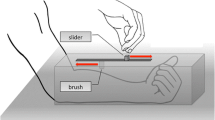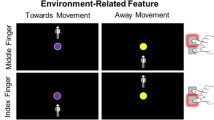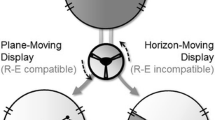Abstract
Voluntary actions are guided by sensory anticipations of body-related as well as environment-related action effects. Even though action effects in the environment typically resemble the action goal proper, anticipations of body-related effects can cause interference if they do not correspond to intended environment-related effects. The present study explored which specific response features cause such interference: the spatial location of the moving limb or its anatomical connection to the body causes such interference? Using a response–effect compatibility design with normal and crossed hand-key mappings, we show that environment-related effects are predominantly related to spatial rather than anatomical response features, ensuring that goal-directed behavior is flexible and efficient at the same time. Furthermore, results indicate that this mechanism applies to both, free- and forced-choice actions.




Similar content being viewed by others
Notes
The term goal is used very heterogeneously in the psychological literature and can refer to both the spatial end point of a movement and more abstract goals such as intended changes in the environment. For the following argument, we will use the term goal exclusively with the latter connotation, whereas we refer to a movement’s end point as spatial response feature.
Please note that an instruction to use either a specific key or a specific hand would have been likely to bias the participants’ coding of the response—at least such an effect would be predicted by an intentional-weighting account (Hommel 1996). The same argument holds true if either key-effect or hand-effect mapping would have been constant throughout the experiment, rendering the constant mapping more reliable than the other mapping. This, however, was not the question of the present study. Instead, we aimed at studying which feature would be used preferentially if participants can freely choose what to do in situations that do not favor one or the other feature.
The color stimuli in Experiment 2 did not carry an inherent spatial meaning as the arrows in Experiment 1 did. Still these color stimuli may have become linked to spatial features (and eventually acquire the power to activate them) by the instructions to shoot either a left or right chicken (see Metzker and Dreisbach 2009 for a similar logic). The merely acquired spatial meaning of color stimuli compared with the inherent spatial meaning of arrows may also explain the somewhat smaller effect size of the interaction of hand-key mapping and choice mode in Experiment 2 compared with Experiment 1.
References
Ansorge U (2002) Spatial intention–response compatibility. Acta Psychol 109:285–299
Ansorge U, Wühr P (2004) A response-discrimination account of the Simon effect. J Exp Psychol Hum 30:365–377
Berlucchi G, Crea F, Di Stefano M, Tassinari G (1977) Influence of spatial stimulus-response compatibility on reaction time of ipsilateral and contralateral hand to lateralized light stimuli. J Exp Psychol Hum 3:505–517
Butz MV, Herbort O, Hoffmann J (2007) Exploiting redundancy for flexible behavior: unsupervised learning in a modular sensorimotor control architecture. Psychol Rev 114:1015–1046
Conde E, Jazenko F, Fraga Filho RS, Harth da Costa D, Torro-Alves N, Cavallet M, Gawryszewski LG (2011) Stimulus affective valence reverses spatial compatibility effect. Psychol Neurosci 4:81–87
Dittrich K, Rothe A, Klauer KC (2012) Increased spatial salience in the social Simon task: a response-coding account of spatial compatibility effects. Atten Percept Psychophys 74:911–929
Dolk T, Hommel B, Colzato LS, Schütz-Bosbach S, Prinz W, Liepelt R (2011) How “social” is the social Simon effect? Front Psychol 2:1–9
Elsner B, Hommel B (2001) Effect anticipation and action control. J Exp Psychol Hum 27:229–240
Guagnano D, Rusconia E, Umiltà CA (2010) Sharing a task or sharing space? On the effect of the confederate in action coding in a detection task. Cognition 114:348–355
Heister G, Schröder-Heister P, Ehrenstein WH (1990) Spatial coding and spatio-anatomical mapping: evidence for a hierarchical model of spatial stimulus-response compatibility. In: Proctor RW, Reeve TG (eds) Stimulus-response compatibility: an integrated perspective. North-Holland, Amsterdam, pp 117–143
Herwig A, Horstmann G (2011) Action-effect associations revealed by eye movements. Psychon Bull Rev 18:531–537
Herwig A, Prinz W, Waszak F (2007) Two modes of sensorimotor integration in intention-based and stimulus-based actions. Q J Exp Psychol 60:1540–1554
Hoffmann J, Lenhard A, Sebald A, Pfister R (2009) Movements or targets: what makes an action in action effect learning? Q J Exp Psychol 62:2433–2449
Hommel B (1993) Inverting the Simon effect by intention. Psychol Res 55:270–279
Hommel B (1996) The cognitive representation of action: automatic integration of perceived action effects. Psychol Res 59:176–186
Hommel B (2004) Event files: feature binding in and across perception and action. Trends Cogn Sci 8:494–500
Hommel B (2011) The Simon effect as tool and heuristic. Acta Psychol 136:189–202
Hommel B, Müsseler J, Aschersleben G, Prinz W (2001) The theory of event coding (TEC): a framework for perception and action planning. Behav Brain Sci 24:849–937
Hommel B, Proctor RW, Vu KPL (2004) A feature-integration account of sequential effects in the Simon task. Psychol Res 68:1–17
James W (1890/1981) The principles of psychology. Harvard University Press, Cambridge
Janczyk M, Skirde S, Weigelt M, Kunde W (2009) Visual and tactile action effects determine bimanual coordination performance. Hum Mov Sci 28:437–449
Janczyk M, Pfister R, Kunde W (2012a) On the persistence of tool-based compatibility effects. J Psychol 220:16–22
Janczyk M, Pfister R, Crognale MA, Kunde W (2012b) Effective rotations: action-effects determine the interplay of mental and manual rotations. J Exp Psychol Gen 141:489–501
Kiesel A, Hoffmann J (2004) Variable action effects: response control by context-specific effect anticipations. Psychol Res 68:155–162
Klapp ST, Greim DM, Mendicino CM, Koenig RS (1979) Anatomic and environmental dimensions of stimulus-response compatibility: implication for theories of memory coding. Acta Psychol 43:367–379
Kunde W (2001) Response-effect compatibility in manual choice reaction tasks. J Exp Psychol Hum 27:387–394
Kunde W, Wühr P (2004) Actions blind to conceptually overlapping stimuli. Psychol Res 68:199–207
Kunde W, Koch I, Hoffmann J (2004) Anticipated action effects affect the selection, initiation, and execution of actions. Q J Exp Psychol A 57:87–106
Kunde W, Müsseler J, Heuer H (2007) Spatial compatibility effects with tool use. Hum Factors 49:661–670
Kunde W, Lozo L, Neumann R (2011) Effect-based control of facial expressions. Evidence from action-effect compatibility. Psychon Bull Rev 18:820–826
Mechsner F, Knoblich G (2004) Do muscles matter for coordinated action? J Exp Psychol Hum 30:490–503
Mechsner F, Kerzel D, Knoblich G, Prinz W (2001) Perceptual basis of bimanual coordination. Nature 414:69–73
Memelink J, Hommel B (2012) Intentional weighting: a basic principle in cognitive control. Psychol Res. doi:10.1007/s00426-012-0435-y
Metzker M, Dreisbach G (2009) Bidirectional priming processes in the Simon task. J Exp Psychol Hum 6:1770–1783
Müsseler J, Hommel B (1997) Blindness to response-compatible stimuli. J Exp Psychol Hum 23:861–872
Müsseler J, Skottke EM (2011) Compatibility relations with simple lever tools. Hum Factors 53:383–390
Pfister R, Kiesel A, Melcher T (2010) Adaptive control of ideomotor effect anticipations. Acta Psychol 135:316–322
Pfister R, Kiesel A, Hoffmann J (2011) Learning at any rate: action-effect learning for stimulus-based actions. Psychol Res 75:61–65
Pfister R, Heinemann A, Kiesel A, Thomaschke R, Janczyk M (2012) Do endogenous and exogenous action control compete for perception? J Exp Psychol Hum 38:279–284
Rieger M (2007) Letters as visual action-effects in skilled typing. Acta Psychol 126:138–153
Riggio L, Gawryszewski LG, Umiltá C (1986) What is crossed in crossed-hand effects? Acta Psychol 62:89–100
Shin YK, Proctor RW, Capaldi EJ (2010) A review of contemporary ideomotor theory. Psychol Bull 136:943–974
Simon JR, Rudell AP (1967) Auditory S-R compatibility: the effect of an irrelevant cue on information processing. J Appl Psychol 51:300–304
Simon JR, Hinrichs JV, Craft JL (1970) Auditory S-R compatibility: reaction time as a function of ear–hand correspondence and ear–response–location correspondence. J Exp Psychol 86:97–102
Ticini LF, Schütz-Bosbach S, Weiss C, Casile A, Waszak F (2012) When sounds become actions: higher-order representation of newly learnt action sounds in the human motor system. J Cogn Neurosci 24(2):464–474
Wallace RJ (1971) S-R compatibility and the idea of a response code. J Exp Psychol 88:354–360
Weigelt M, Rieger M, Mechsner F, Prinz W (2007) Target-related coupling in bimanual reaching movements. Psychol Res 71:438–447
Wolfensteller U, Ruge H (2011) On the timescale of stimulus-based action-effect learning. Q J Exp Psychol 64:1273–1289
Author information
Authors and Affiliations
Corresponding author
Rights and permissions
About this article
Cite this article
Pfister, R., Kunde, W. Dissecting the response in response–effect compatibility. Exp Brain Res 224, 647–655 (2013). https://doi.org/10.1007/s00221-012-3343-x
Received:
Accepted:
Published:
Issue Date:
DOI: https://doi.org/10.1007/s00221-012-3343-x




